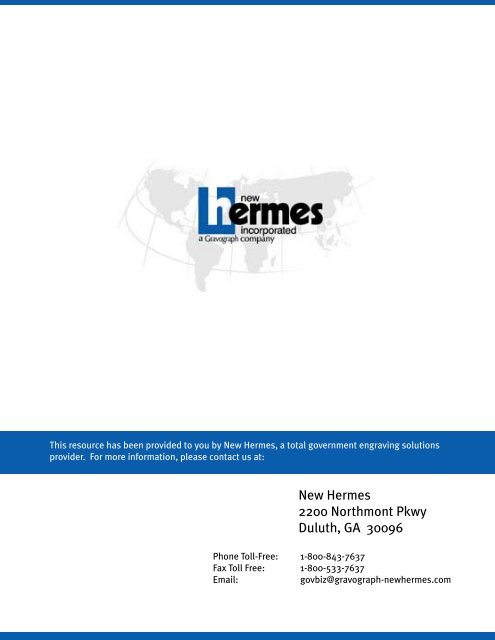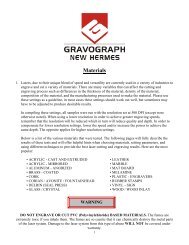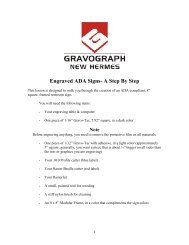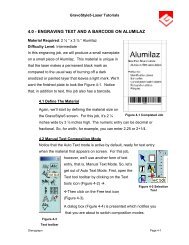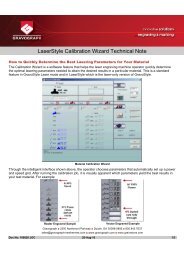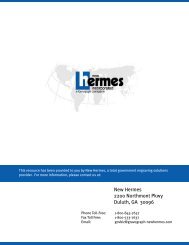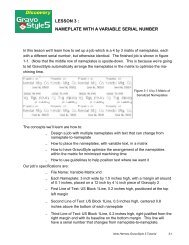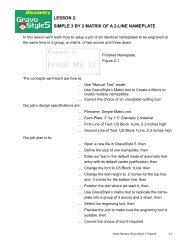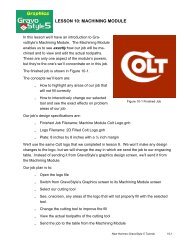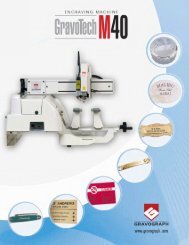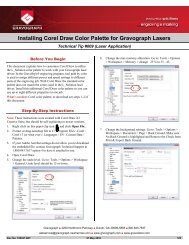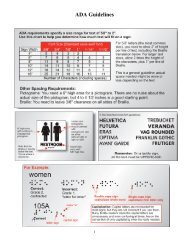How to ensure engraving quality - Gravograph-New Hermes
How to ensure engraving quality - Gravograph-New Hermes
How to ensure engraving quality - Gravograph-New Hermes
You also want an ePaper? Increase the reach of your titles
YUMPU automatically turns print PDFs into web optimized ePapers that Google loves.
This resource has been provided <strong>to</strong> you by <strong>New</strong> <strong>Hermes</strong>, a <strong>to</strong>tal government <strong>engraving</strong> solutions<br />
provider. For more information, please contact us at:<br />
<strong>New</strong> <strong>Hermes</strong><br />
2200 Northmont Pkwy<br />
Duluth, GA 30096<br />
Phone Toll-Free: 1-800-843-7637<br />
Fax Toll Free: 1-800-533-7637<br />
Email:<br />
govbiz@gravograph-newhermes.com
Quality Control<br />
Carpenters and woodworkers have an old saying: “Measure twice, cut once.” The same<br />
theory could be applied <strong>to</strong> manufacturing signs. Check everything twice before you press<br />
the “Go” but<strong>to</strong>n on the machine. Remember, the machine will do exactly what you tell it<br />
<strong>to</strong> do, which isn’t necessarily what you meant; computers are not yet capable of reading<br />
minds.<br />
Before you send the job <strong>to</strong> the <strong>engraving</strong> table:<br />
1. Take a look at the sign as it appears on the screen. Is everything where it should<br />
be Are the various elements centered, or left justified, uniformly Does any text<br />
need kerning adjustment Is the spelling correct<br />
2. Do you have the correct cutter in the spindle Are the depth and Z set correctly<br />
3. Check your <strong>engraving</strong> settings. Does the origin setting on the screen match the<br />
actual origin of the machine Are the speed, depth, dwell, and other settings<br />
appropriate for the material you are <strong>engraving</strong><br />
4. Is the material in the correct spot on the table Is it the correct material Are there<br />
any flaws in the material that will make the finished sign useless<br />
If everything looks good, start <strong>engraving</strong>. Make one sign, from start <strong>to</strong> finish, and check<br />
it against the cus<strong>to</strong>mer’s specifications. Some cus<strong>to</strong>mers may ask for one finished sign as<br />
a proof before beginning production; even if they don’t, make the first sign a proof for<br />
yourself. Measure <strong>to</strong> make sure things are where they should be; machine settings can<br />
drift, and can easily be adjusted back <strong>to</strong> “in spec.”<br />
Most of the time, if the first sign is good, the rest of them will be, <strong>to</strong>o. <strong>How</strong>ever, don’t<br />
make this assumption! Anyone can mistype a word or misalign a part, so don’t assume<br />
you’re immune. Check your work carefully; if possible, have someone else proof read<br />
your signs for you. What one pair of eyes may miss, another may catch. On a long<br />
1
production run, check every 10 th or 20 th sign <strong>to</strong> make sure the machine settings are still<br />
accurate.<br />
Don’t be in a hurry! A <strong>quality</strong> product, finished later, is of far higher value than a poor<br />
product, finished now. And it takes much longer <strong>to</strong> correct mistakes than <strong>to</strong> not make<br />
them in the first place. Even if a job is a “rush,” take the time <strong>to</strong> <strong>ensure</strong> it only has <strong>to</strong> be<br />
done once. Plan your time according <strong>to</strong> a fair estimate of how long a job will take, and<br />
don’t let anyone rush you in<strong>to</strong> making a mistake.<br />
Always be alert and looking for errors. From the time you create a file <strong>to</strong> the time you<br />
pack the finished sign for shipping, you should constantly be checking for mistakes and<br />
problems. If you don’t feel right about something, it usually isn’t right, so go back and<br />
check it again.<br />
2


